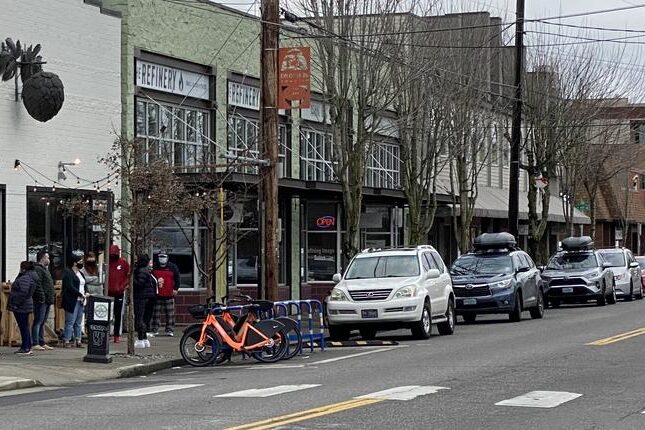Local Taxes & Household Budgets
This report produced by the Portland Business Alliance, takes a closer look at the impact new local taxes are having on household budgets, with analysis provided by ECONorthwest.
As we wrap up a year of economic challenges, we wanted to take a closer look at the cumulative impact these new taxes have had on Portland area households. We also wanted to understand the tax burden Portland households experience as compared to other peer regions. The increase of tax incidence to households, coupled with the freefall in housing construction, have set our region on a path of increasing unaffordability.
Why this matters
It’s important to note that the objectives of the recently passed local measures are all overall laudable. In fact, the Portland Business Alliance endorsed nearly every single one of them. However, the astounding rise in the cost of living in our region can be linked to increased taxes, coupled with the inability to produce housing at levels necessary to meet rising population. As the data points below demonstrate, there is a rising tax burden in Portland that has become regressive, due in large part to our inability to tax consumption, and reliance on property tax. In this report, we look closely at households filing taxes jointly with 2018 personal incomes of $50,000, $75,000, $150,000, and $300,000, acknowledging that the median household income for our region is $78,439.
In a time when our city’s household budgets are already constrained due to rising rents, costs of housing and unemployment, it’s important to note the impact additional considerations of new taxes are having to the average family.
Tax burden and peer regions
And as you can see by the chart below, even without a consumption-based tax, the household tax burden on all income earners has increased significantly, and is greater than all our peer regions at every income bracket.
Impact of new, local taxes
Since 2018, eight new tax measures have been imposed on Portland households and businesses.
To better understand the cumulative impact of these new taxes on household budgets, the teams at ECONorthwest estimated the incidence of each new tax.
The taxes analyzed include two property tax levies (the Metro Housing Bond, passed in 2018 and the Portland Parks Levy, passed in 2020); taxes associated with the statewide Student Success Act of 2019 (personal income tax reduction and new corporate activities tax); the Portland Clean Energy Surcharge (PCES), passed in 2018; increases in the Portland business license tax (BLT) and the Multnomah business income tax (BIT); taxes associated with the Metro Homeless Services ballot measure passed in 2020 (business and personal income taxes); and the Preschool For All personal income tax, also passed in 2020.
While several of these taxes apply partially to residents outside of Portland, the analysis captured the impact on households within the City of Portland. Specifically assessing the impact of the identified taxes, assuming they were fully implemented during 2018, on households filing taxes jointly with 2018 personal incomes of $50,000, $75,000, $150,000, and $300,000, with the median household income for our region being $78,439.
The resulting estimates are designed as a starting point in considering the net effect of recently passed taxes. That is, to illustrate the magnitude of recent tax increases and the general pattern of incidence across income levels. (This analysis does not attempt to fully describe either the distributional impacts or quantify all potentially foreseeable dynamic effects of the taxes.)
Notable taxes in peer regions:
SEATTLE: Payroll tax on high salaries (2021); Long-term care payroll tax (2025).
SALT LAKE CITY: Property tax increase of 7.88% (2020).
AUSTIN: 4% permanent increase in property taxes for Project Connect (2020).
NASHVILLE: 34% increase in property taxes for police and schools (2020).
INDIANAPOLIS: Gradual decrease in CIT through 2022.
Related Report
DATA ANALYSIS & SOURCES:
Data and analysis provided by ECONorthwest.
The teams at ECONorthwest relied heavily on a study by the Government of the District of Columbia (the “D.C. study”) to quantify the potential incidence of the property taxes and understand the baseline tax burden borne by the households described above. Where applicable, they relied on recent estimates of the revenue generating potential of each tax.
For the property taxes they relied on the rate increases implemented with each measure. To estimate the incidence of the property tax measures they used the baseline property tax estimates from the D.C. study and assigned an incidence proportionate to property tax increases relative to the baseline rate. The resulting estimates appear relatively large compared to a similar estimate from a Portland State University (PSU) study of the levy’s burden on households with the median assessed home value. They therefore reduced their estimates by approximately 30 percent to better align with the PSU study.
To estimate the incidence of the SSA taxes they relied on Oregon’s Legislative Revenue Office (LRO) 2019 analysis of the dynamic effects of the SSA. The LRO analysis provides the net effect on real disposable household income for households in selected ranges of disposable income. They relied on a 2016 LRO analysis of IP 28, a proposed statewide gross receipts tax, to estimate the potential incidence of the PCES. This analysis presents household income effects similar to those described for the SSA analysis, above. We scale these impacts based using tax revenue as a share of personal income for the state (IP 28) and the City (PCES). The PCES restricts the surcharge to large businesses operating in Portland, as a result, the LRO analysis of IP 28, which had a broader base, makes our analysis of the PCES potentially more speculative than that of other taxes described in this document.
We use a common approach to estimating the effect of increases in the Portland Business License Tax (BLT), the Multnomah County Business Income Tax (BIT), and the new Metro Homeless Services business tax. We assume that households bear 25 percent of the increased tax burden, consistent with national literature on the burden of business taxes and LRO estimates of the share of corporate taxes that is exported (we do not account for the increased tax burden of business owners in the city). We then allocate this burden in proportion to the estimated share of all wage and salary income earned by the model households.

